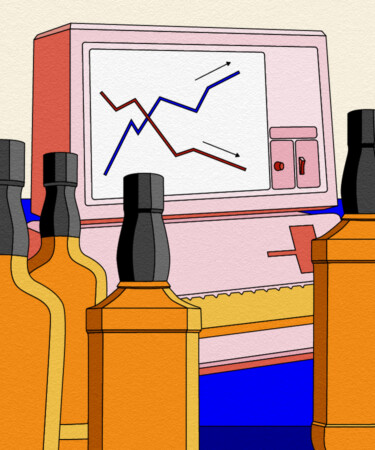With today’s loyal patrons and cult collectors, it’s hard to imagine a time when the Scotch whisky industry wasn’t booming. But in the mid-1980s, that was exactly the case.
While the cast of “Cheers” may have been hamming it up on screen, the ‘80s was a dismal era for whisky and, more specifically, Scotch whisky. During this time, the industry suffered greatly from the seesaw-like effects of overproduction and declining demand — a problem that ultimately led to the closure of several prominent distilleries.
These dark days of whisky are often politely described as an industry-wide excess of inventory, but Scotch fans know it best as the Whisky Loch — translating to Whiskey Lake in reference to the country’s surplus predicament.
It was around this time that U.S drinkers began to prefer lighter spirits like white rum and vodka over whiskey, and though Scotch had been dominating the market in years prior, its popularity began to fizzle out. This, among other variables, contributed to a decline of the Scottish whisky market that was almost terminal.
Increased oil prices in the U.S during the late ‘70s were catalysts in the global economic decline that occurred in the following decade. Japanese whisky — which was gaining traction in its local market — also felt the constricting effects of the recession, forcing a wave of closures. Another factor leading to the loch was producers’ miscommunication with distributors, which convinced whisky makers to continue production in the belief that they could offload any surplus supply.
By 1985, the list of distillery closures read more like an industry roll call: Brora, Coleburn, Dallas Dhu, Glenesk, Glenlochy, Glen Mhor, Hillside, Linlithgow, Millburn, Moffat, Glen Albyn, North Port, Glen Flagler, and many more shuttered. Some closed their doors in hopes of reopening in the future while others were bulldozed and destroyed forever.
At some point in 1981, the whisky industry began reducing production to avoid exacerbating the dilemma. Slowly but surely, the market began to recover, and legacy facilities such as Ardbeg, which was on the brink of extinction, came back to life.
These days, there is an exciting energy surrounding the category, and certain once-shuttered distilleries — like the famed Port Ellen distillery — now produce some of the most sought-after bottles in the world.
This red-hot demand has caused some to wonder if a new loch will soon be ushered in. They say hindsight is 20/20, but hopefully, both producers and consumers can learn from mistakes made during whisky’s darkest days and leave this misfortune in the past.
